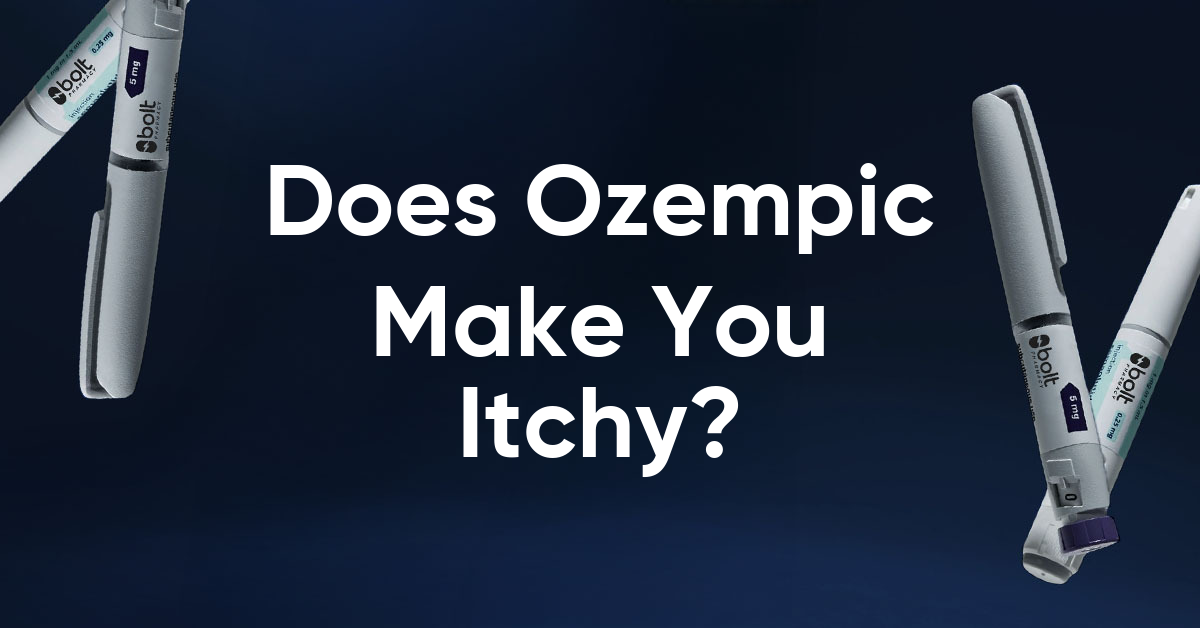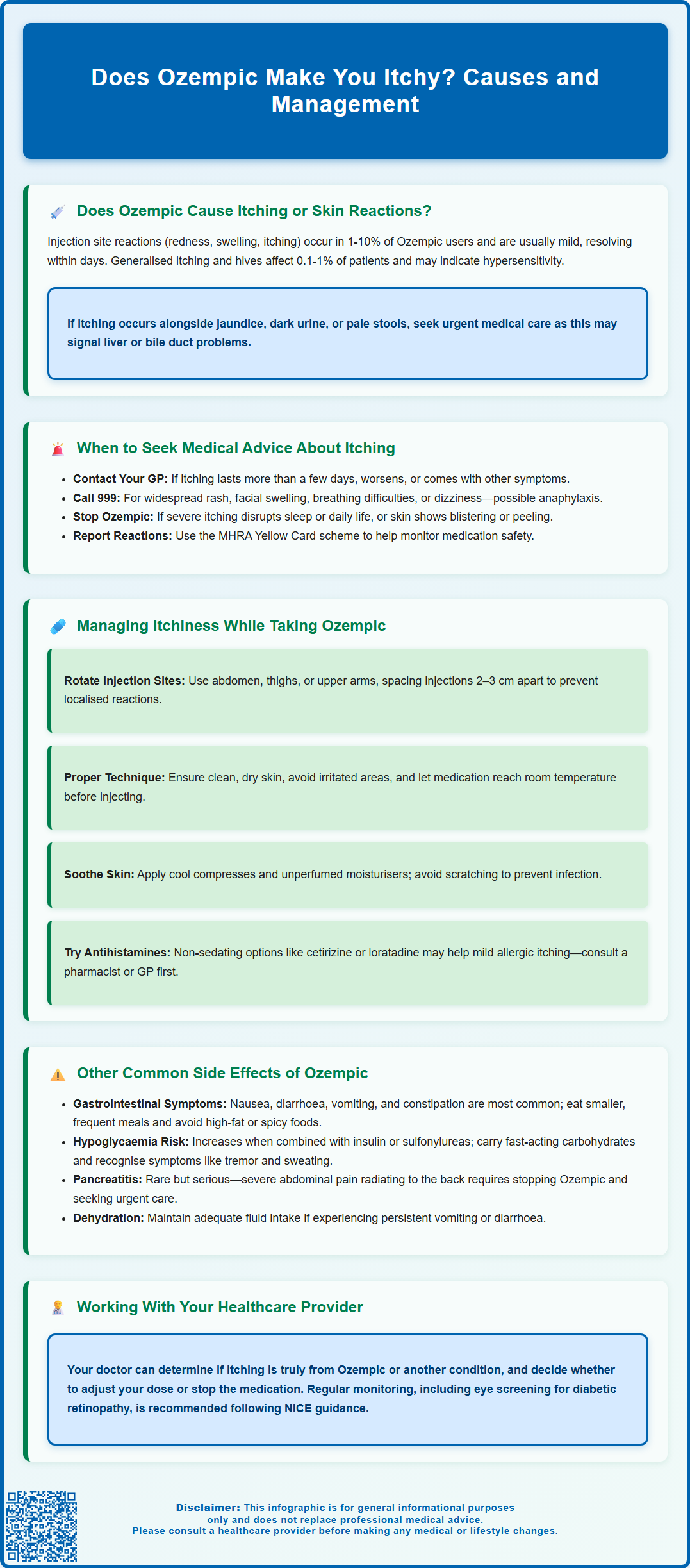Mounjaro®
Dual-agonist support that helps curb appetite, hunger, and cravings to drive substantial, sustained weight loss.
- ~22.5% average body weight loss
- Significant weight reduction
- Improves blood sugar levels
- Clinically proven weight loss

Does Ozempic make you itchy? Ozempic (semaglutide) is a GLP-1 receptor agonist licensed in the UK for type 2 diabetes mellitus. Whilst gastrointestinal side effects are well-recognised, some patients report itching or skin reactions during treatment. Injection site reactions—including localised itching, redness, and swelling—are common, affecting 1–10% of patients. Generalised itching (pruritus) and urticaria (hives) are less frequent, occurring in 0.1–1% of patients. Understanding when itching is benign and when it signals a more serious allergic reaction is essential for safe medication use. This article examines the dermatological effects of Ozempic, when to seek medical advice, and practical management strategies.
Summary: Ozempic can cause itching, most commonly as mild, localised injection site reactions affecting 1–10% of patients, with generalised pruritus or urticaria occurring less frequently in 0.1–1% of patients.
Ozempic (semaglutide) is a glucagon-like peptide-1 (GLP-1) receptor agonist licensed in the UK for the treatment of type 2 diabetes mellitus. While gastrointestinal side effects such as nausea and diarrhoea are well-documented, some patients report experiencing itching or pruritus during treatment.
Injection site reactions are amongst the most commonly recognised dermatological effects associated with Ozempic. These typically manifest as localised redness, swelling, or itching at the site where the subcutaneous injection is administered—usually the abdomen, thigh, or upper arm. Such reactions are generally mild and transient, resolving within a few days without specific intervention. The MHRA's Summary of Product Characteristics for Ozempic lists injection site reactions as common adverse effects (occurring in 1-10% of patients).
Beyond localised reactions, generalised itching (pruritus) and urticaria (hives) are listed as uncommon adverse reactions (affecting 0.1-1% of patients) in the Ozempic SmPC. These may be related to hypersensitivity reactions, which range from mild skin rashes to more serious allergic responses. Individual susceptibility varies, and some patients may experience more pronounced symptoms than others.
It is important to distinguish between mild, self-limiting itchiness and symptoms that may indicate a more serious allergic reaction, such as angioedema or anaphylaxis. Patients experiencing new or worsening skin symptoms should monitor their response carefully and seek appropriate medical guidance to ensure safe continuation of therapy. If generalised itching occurs with jaundice, dark urine or pale stools, urgent medical review is needed to investigate possible hepatobiliary disease.

Whilst mild itching at the injection site is often benign and self-limiting, certain symptoms warrant prompt medical evaluation. Patients should contact their GP or diabetes specialist nurse if itching persists beyond a few days, worsens progressively, or is accompanied by other concerning features.
Signs of a potential allergic reaction include:
Widespread rash or hives (urticaria) affecting multiple areas of the body
Swelling of the face, lips, tongue, or throat (angioedema)
Difficulty breathing or swallowing
Dizziness, rapid heartbeat, or feeling faint
These symptoms may indicate anaphylaxis, a medical emergency requiring immediate attention. Patients experiencing such reactions should stop using Ozempic and call 999 or attend A&E immediately. For urgent but non-emergency concerns, NHS 111 can provide appropriate guidance.
Additionally, if itching is severe enough to disrupt sleep, daily activities, or quality of life, or if it is associated with skin changes such as blistering, peeling, or significant inflammation, medical review is advisable. The prescribing clinician can assess whether the reaction is likely related to Ozempic, consider alternative diagnoses (such as eczema, contact dermatitis, or unrelated skin conditions), and determine whether dose adjustment or discontinuation is necessary.
Patients should stop using Ozempic and seek medical advice if they suspect a moderate to severe hypersensitivity reaction. Suspected adverse reactions can be reported through the MHRA Yellow Card scheme (yellowcard.mhra.gov.uk or via the Yellow Card app), which helps regulatory authorities monitor medication safety.
For patients experiencing mild, localised itching at the injection site, several practical strategies may provide relief and reduce the likelihood of recurrence. Rotating injection sites is essential—using the same area repeatedly can increase the risk of localised reactions and discomfort. The abdomen, thighs, and upper arms should be used in rotation, with each injection administered at least 2–3 cm away from the previous site.
Proper injection technique is equally important. Patients should ensure the skin is clean and dry before injecting and avoid injecting into areas with visible irritation, bruising, or scarring. While not mandatory, allowing the medication to reach room temperature (removing the pen from the refrigerator 15–30 minutes beforehand) may reduce discomfort during injection. Patients should always follow the storage and handling instructions in the Ozempic Patient Information Leaflet. Applying a cool compress to the injection site after administration may soothe mild itching or redness.
If generalised itching occurs, patients should avoid scratching, as this can exacerbate skin irritation and increase the risk of secondary infection. Emollients and moisturisers (such as aqueous cream or unperfumed lotions) can help maintain skin hydration and barrier function. Over-the-counter non-sedating antihistamines (e.g., cetirizine or loratadine) may provide symptomatic relief for mild allergic-type itching, though patients should consult a pharmacist or GP before starting any new medication.
Wearing loose, breathable clothing made from natural fibres such as cotton can reduce skin irritation, particularly in warmer weather. Patients should also review other potential triggers, including new skincare products, detergents, or environmental allergens, which may coincide with starting Ozempic and contribute to pruritus.
If itching persists despite these measures, a medication review with the prescribing clinician is warranted. In some cases, temporary dose reduction, switching to an alternative GLP-1 receptor agonist, or discontinuation may be necessary. NICE guidance emphasises individualised treatment decisions, balancing therapeutic benefit against tolerability and patient preference.
Understanding the broader side effect profile of Ozempic helps patients and clinicians contextualise itching within the overall safety profile of the medication. Gastrointestinal symptoms are the most frequently reported adverse effects, particularly during dose initiation and escalation. These include:
Nausea (very common, affecting more than 1 in 10 patients)
Diarrhoea and vomiting (common)
Constipation and abdominal pain (common)
Dyspepsia and flatulence (common)
These symptoms typically diminish over time as the body adjusts to the medication. Eating smaller, more frequent meals and avoiding high-fat or spicy foods may help mitigate gastrointestinal discomfort.
Hypoglycaemia (low blood sugar) can occur, particularly when Ozempic is used in combination with insulin or sulfonylureas. The doses of these medications may need to be reduced when starting Ozempic. Patients should be educated on recognising symptoms such as tremor, sweating, confusion, and palpitations, and advised to carry fast-acting carbohydrates.
Injection site reactions, as discussed, are common and usually mild. Other dermatological effects, though less frequent, include rash and pruritus.
Pancreatitis (inflammation of the pancreas) is a serious but rare adverse effect that presents with severe, persistent abdominal pain radiating to the back, often accompanied by nausea and vomiting. Patients experiencing such symptoms should stop taking Ozempic immediately and seek urgent medical attention.
Gallbladder disease, including gallstones, has been reported with GLP-1 receptor agonists. Patients should seek medical advice if they experience symptoms such as severe upper abdominal pain, often after meals.
Severe gastrointestinal side effects may lead to dehydration, which can affect kidney function. Patients should maintain adequate fluid intake and seek medical advice if they experience persistent vomiting or diarrhoea.
Animal studies have shown thyroid C-cell tumours with semaglutide, though the relevance to humans is unknown. Patients should report any unusual neck symptoms such as a lump, persistent hoarseness, or difficulty swallowing.
Diabetic retinopathy complications have been reported, particularly in patients with pre-existing retinopathy experiencing rapid improvements in glycaemic control. Regular ophthalmological screening is recommended in line with NICE guidance for diabetes management and the NHS Diabetic Eye Screening Programme.
Patients should report any suspected side effects to their healthcare team and can also report them directly to the MHRA Yellow Card scheme at yellowcard.mhra.gov.uk or via the Yellow Card app.
Yes, localised itching at the injection site is a common reaction, affecting 1–10% of patients. It is usually mild, transient, and resolves within a few days without specific treatment.
Seek immediate medical attention if you experience widespread rash, facial swelling, difficulty breathing, or dizziness, as these may indicate anaphylaxis. Contact your GP if itching persists, worsens, or disrupts daily life.
Over-the-counter non-sedating antihistamines such as cetirizine or loratadine may provide symptomatic relief for mild allergic-type itching. Consult a pharmacist or GP before starting any new medication.
The health-related content published on this site is based on credible scientific sources and is periodically reviewed to ensure accuracy and relevance. Although we aim to reflect the most current medical knowledge, the material is meant for general education and awareness only.
The information on this site is not a substitute for professional medical advice. For any health concerns, please speak with a qualified medical professional. By using this information, you acknowledge responsibility for any decisions made and understand we are not liable for any consequences that may result.
Lorem ipsum dolor sit amet, consectetur adipiscing elit, sed do eiusmod tempor incididunt ut labore et dolore magna aliqua. Ut enim ad minim veniam, quis nostrud exercitation ullamco laboris nisi ut aliquip ex ea commodo consequat. Duis aute irure dolor in reprehenderit in voluptate velit esse cillum dolore eu fugiat nulla pariatur.
Block quote
Ordered list
Unordered list
Bold text
Emphasis
Superscript
Subscript